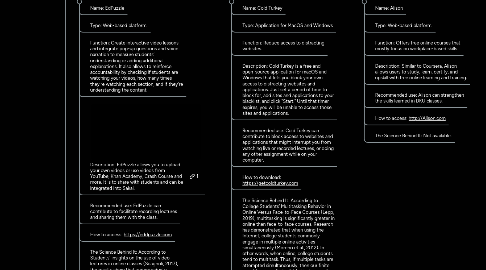
1. Communication Tools
1.1. EddPuzzle
1.1.1. Name: EdPuzzle
1.1.2. Type: Web-based platform.
1.1.3. Function: Create interactive video lessons and integrate pop-up questions and voice narration to measure students’ understanding or adding additional explanations. It also allows to reinforce accountability by checking if students are watching your videos, how many times they're watching each section, and if they're understanding the content.
1.1.4. Description: EdPuzzle allows you to upload your own videos or use videos from YouTube, Khan Academy, Crash Course and more. It is to share with students and can be integrated into Sakai.
1.1.5. Recommended use: EdPuzzle can contribute to facilitate recording lectures and sharing them with the class.
1.1.6. How to access: https://eddpuzzle.com
1.1.7. The Science Behind It: According to Students' insights on the use of video lectures in online classes (Scagnoli, 2017), the results show that undergraduate students favor multiple choice and quiz assignments as opposed to graduate students. Besides in the courses studied, most video lectures (VL) in undergraduate classes were connected to graded quiz questions, so undergraduates would not consider removing quizzes because they connect them to actions for learning. When video is used merely to replicate a classroom lecture, its true strengths and pedagogical characteristics are ignored (Bates, 2015). VL are considered more valuable if they are integrated with the other elements of a class especially to assessment. Similar to what other studies found (Bouwmeester et al., 2013; Gikandi et al., 2011; Johnston, 2015), the connection of VL to activities or as feedback enhanced students' motivation in watching them.
1.2. Slack
1.2.1. Name: Slack
1.2.2. Type: Application for MacOS and Windows, Web-based platform, and Mobile compatible.
1.2.3. Function: Messaging app and collaboration hub for teams.
1.2.4. Description: Slack is a collaboration hub, where information is shared in form of messages, attachments, links, etc. In Slack, conversations happen in channels — organized by topic, project, team, or whatever makes sense for your needs. Slack integrates with the apps and services you and you already use every day. Information flows into the stream of conversation so everyone can see it — or act on it — inside Slack. Applications such as Zoom, DukeBox, Google Drive are compatible with Slack.
1.2.5. Recommended use: Slack can contribute to manage teams through project-focused channels.
1.2.6. How to download/Access: https://slack.com
1.2.7. The Science Behind It: According to Learning analytics in collaborative learning supported by Slack: From the perspective of engagement (Zhang, Meng, 2016), with the help of Slack in the collaboration learning, students can communicate, discuss, brainstorm their idea and share knowledge in groups. These are consistent with the three parts of engagement theory. We tend to explore important factors influencing students' teamwork engagement and reduce the free-rider effect in group learning with the help of Slack. This provides teachers a way to know the contributions of each member in a learning group and this can also be an important basis of one's final score. Under this circumstance, score is not just be related to team performance, it is also dependent on one's effort manifested on Slack. It is more scientific and comprehensive to evaluate a student's performance in group learning.
1.2.8. According to Slack: Adopting Social-Networking Platforms for Active Learning (Sabin, 2018), students expressed that the dynamism of the platform allowed for greater interaction and conversation—a key component of active and social learning approaches. As one student stated, “It’s a great way to start a discussion as opposed to just using the Blackboard discus-sion board (as I have used previously in another online class).” The study concludes that active and social learning exercises were a central component of the online tutorials, and course discussion was facilitated through the third-party platform Slack. The study included professors’ opinions on the use of the platform: “Slack is a way to provide a “state of being there when using an outside medium” as well as a way for the professor to reduce “psychological distance in interpersonal communication” (Gunderson et al. 2014, 338; Short, Williams, and Christie 1976).”
2. Self-learning
2.1. Alison
2.1.1. Name: Alison
2.1.2. Type: Web-based platform.
2.1.3. Function: Offers free online courses that mostly focus on workplace-based skills.
2.1.4. Description: Similar to Coursera, Alison allows users to study, learn, certify, and upskill with free online learning and training.
2.1.5. Recommended use: Alison can strengthen the skills learned in DKU classes.
2.1.6. How to access: http://Alison.com
2.1.7. The Science Behind It: Not available.
3. Additional Academic Resources
3.1. Cold Turkey
3.1.1. Name: Cold Turkey
3.1.2. Type: Application for MacOS and Windows
3.1.3. Function: Reduce access to distracting websites.
3.1.4. Description: Cold Turkey is a free and open-source application for macOS and Windows that lets you block your own access to distracting websites and applications. Just set a period of time to block for, add sites and applications to your blacklist, and click "Start." Until that timer expires, you will be unable to access those sites and applications.
3.1.5. Recommended use: Cold Turkey can contribute to block access to websites and applications that might interrupt you from watching live or recorded lectures, or doing any other assignment while on your computer.
3.1.6. How to download: https://getcoldturkey.com
3.1.7. The Science Behind It: According to College Students’ Multitasking Behavior in Online Versus Face-to-Face Courses (Lepp, 2019), multitasking is significantly greater in online than face-to-face courses. Research has demonstrated that when using the Internet, college students commonly engage in multiple online activities simultaneously (Moreno et al., 2012). In other words, when online, college students tend to multitask. Thus, if multiple tasks are attempted simultaneously, then our finite cognitive capacity is divided between all tasks. This results in less cognitive capacity devoted to each task and a decrease in task performance (Carrier, Rosen, Cheever, & Lim, 2015; Pashler, 1994).
3.1.8. Cold Turkey is expected to contribute to a reduction in multi-tasking now that DKU Students are starting online learning.
